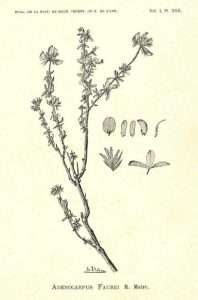At the beginning of the 20th century (1919, 1921) Alphonse Faure collected what seemed to be a new species of the genus Adenocarpus, with small, glabrescent leaves and umbelliform inflorescences, almost always terminal, near Tiaret (Algeria). In 1921 René Maire described it and named it, in honor of his collector, Adenocarpus faurei. It was never seen in other parts, so it was considered very localized endemism of the forests and thickets of that area. In the second half of the 20th century, other researchers searched for it here and in other nearby areas, without success.
Due to the rarity of the species, it was protected in 1993 (Decree 93-285 of November 21), protection that was renewed in 2012 (Executive Decree 12-03 of January 4). But it seemed to be too late. Much of the wooded and semi-wooded areas of Tiaret were cleared, cultivated and urbanized in the second half of the 20th century and continue to be so in the 21st.
For five consecutive years (2012-2017), Miara et al. (2018) have systematically studied the forest vegetation around Tiaret (Guesul Massif), distributing the study area in grids of 1 km2. They have not found the species and, following the IUCN criteria, they considered it extinct. They determined that the main causes of extinction have been growing urbanization and cultivating the old forested areas.
Maire, R. (1921). Les Adenocarpus de l’Afrique du Nord. Extrait du bulletin de la station de recherches forestieres du Nord de l’Afrique, Alger, T (1), 6eme fascicule.
Maire, R. 1987. Adenocarpus. Flore d’Afrique du Nord, vol XVI: 236-237.
Miara, M.D., Hammou, M.A. & Skipper, J. 2018. The extinction of Faure’s Broom Adenocarpus faurei Maire (Leguminosae) in Algeria. Journal of Threatened Taxa 10(5): 11595-11598.


